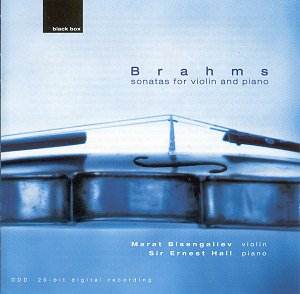The three Brahms sonatas for violin and piano are all
the work of the mature composer, equally masterly, equally satisfying,
but different in personality and outlook.
The G major Sonata, composed towards the end of the
1870s, is exactly contemporary with Brahms's Violin Concerto. In both
works the composer was paying a sincere tribute to his performer friend
Joseph Joachim, and the natural lyricism of the music is a reflection
of the nature of the violin itself. Indeed the balance between the two
instruments is particularly successful, while much of the melodic material
reveals that the work is the creation of an experienced song composer.
The performance of Marat Bisengaliev and Sir Ernest
Hall responds well to these admirable characteristics, confirming (as
in the other sonatas too) that the violin is the most lyrical of instruments,
and that Brahms was a master of the piano too. This makes for a compelling
combination, and these are masterworks to be sure. On hearing these
performances these strengths are abundantly clear, which is praise enough.
While there may be performances by famous violinists
and duo combinations which wring even greater individuality from the
music, there is no need to cavil in respect of what Black Box offers
here. The G major Sonata is among the composer's most sunny and lyrical
creations, and with such well judged tempi and sensitive phrasing this
is particularly enjoyable.
The other sonatas are equally inspired, and in the
case of Opus 100, equally song-like. These characteristics are immediately
apparent, since the opening gesture so strongly resembles the Prize
Song from Wagner's Mastersingers. But the theme which evolves from it
is genuinely Brahmsian, with abundant warmth and an expressive strength
which is founded upon the balance between the two instruments. The arts
combine most effectively to communicate these features of this appealing
and warm composition, aided by a sensitive recorded ambience.
The third and last Sonata, composed towards the end
of the 1880s, is a darker and more complex piece. Dedicated to the pianist
and conductor Hans von Bülow, it is somewhat larger in scale than
its two predecessors, largely because it contains an additional movement.
The music has a natural lyricism which reflects upon the nature of the
violin itself. Indeed the balance between the two instruments is particularly
successful, while much of the melodic material reveals once again that
the music is the creation of an experienced song composer.
The greater expressive intensity of this Sonata is
immediately apparent, since the work opens with a sotto voce (whispered)
passage, whose very restraint invites the release of more tempestuous
emotions. Again the artists respond imaginatively, although in this
piece there is greater intensity to be found in the performances of
leading combinations such as Itzhak Perlman and Daniel Barenboim (Sony)
or Kyung-Wha Chung and Peter Frankl (EMI). But make no mistake; this
is great music, and therefore always greater than any single performance
can offer. With excellent insert notes by Martin Anderson and clear,
reliable sound, this Black Box issue can be recommended with confidence
and enthusiasm.
Terry Barfoot

